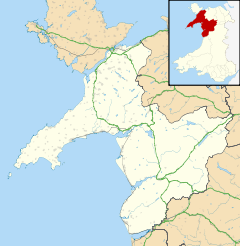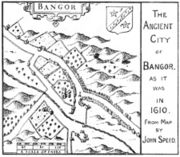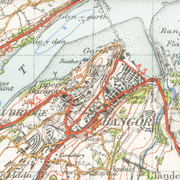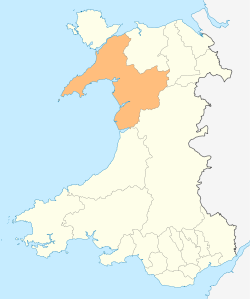Bangor, Gwynedd
| Bangor | |
The City of Bangor, Gwynedd |
|
 Bangor
|
|
| Population | 21,735 (2008 estimate) |
|---|---|
| OS grid reference | |
| - Cardiff | 184 miles (296 km) |
| - London | 258 miles (415 km) |
| Principal area | Gwynedd |
| Ceremonial county | Gwynedd |
| Country | Wales |
| Sovereign state | United Kingdom |
| Post town | BANGOR |
| Postcode district | LL57 |
| Dialling code | 01248 |
| Police | North Wales |
| Fire | North Wales |
| Ambulance | Welsh |
| EU Parliament | Wales |
| UK Parliament | Arfon |
| Welsh Assembly | Arfon |
| List of places: UK • Wales • Gwynedd | |
Bangor is a city in Gwynedd, Wales, and one of the smallest cities in Britain. It is a university city with a population of 13,725 at the 2001 census, not including around 10,000 students at Bangor University. Including nearby Menai Bridge on Anglesey, which does not however form part of the City of Bangor itself, the population is about 18,000. Although it is Wales's fourth largest city, this is somewhat misleading as it only ranks as 36th largest urban area in Wales. According to the census, 46.6% of the population speak Welsh[1].
Contents |
History
The origins of the city date back to the founding of a monastic establishment on the site of Bangor Cathedral by the Celtic saint Deiniol in the early 6th century AD. The name 'Bangor' itself is an old Welsh word for a type of fenced-in enclosure, such as was originally on the site of the cathedral. The present cathedral is a somewhat more recent building and has been extensively modified throughout the centuries.

While the building itself is not the oldest, and certainly not the biggest, the bishopric of Bangor is one of the oldest in Britain. Another claim to fame is that Bangor allegedly has the longest High Street in Wales and the United Kingdom. Friars School was founded as a free grammar school in 1557, and Bangor University was founded in 1884.
Geography
Bangor lies on the coast of north Wales near the Menai Strait which separates the island of Anglesey from Gwynedd. Bangor Mountain lies to the east of the main part of the city, but the large housing estate of Maesgeirchen, originally built as council housing, is to the east of the mountain near Port Penrhyn. Bangor Mountain casts a shadow across the High Street, Glan Adda and Hirael areas, so that from November to March some parts of the High Street in particular receive no direct sunlight. Another ridge rises to the north of the High Street, dividing the city centre from the south shore of the Menai Strait; this area is known as Upper Bangor (Bangor Uchaf).

Bangor has two rivers within its boundaries. The River Adda is a largely culverted watercourse which only appears above ground at its western extremities near the Faenol estate, whilst the River Cegin enters Port Penrhyn at the eastern edge of the city. Port Penrhyn was an important port in the 19th century, exporting the slates produced at the Penrhyn Quarry.
Bangor lies at the western end of the North Wales Path, a 60 mile long-distance coastal walking route to Prestatyn. It is also on routes 5, 8 and 85 of the National Cycle Network.
Bangor railway station, which serves the city, is located on the North Wales Coast Line from Crewe to Holyhead.
Education
Bangor University and Coleg Menai are located in the town. Secondary schools include Ysgol Friars, Ysgol Tryfan, Hillgrove School and St. Gerard's School. There are also a number of primary and infant schools.[2]
Culture
Bangor is an important centre for classical music, with regular concerts given in the Powis and Prichard-Jones Halls as part of the university's Music at Bangor concert series. The city is also home to the Gwynedd Museum and Art Gallery. The University has announced plans for a major new arts centre in the city.[3]
Bangor hosted the National Eisteddfod in 1890, 1902, 1915, 1931, 1940 (through the medium of radio), 1943, 1971 and 2005, as well as an unofficial National Eisteddfod event in 1874.
Media
Radio
Bangor is home to a small BBC broadcasting centre, producing a large amount of output for BBC Radio Cymru. The studios are also the main North Wales newsroom for television, radio and online. The BBC's Light Entertainment Department moved to Bangor during World War II and many classic programmes (like ITMA) came from Bangor.
Bangor is also home to two commercial radio stations, Heart Cymru (serving Anglesey and Gwynedd) and Heart North Wales Coast (serving the North Wales Coast), which share studio facilities on the Parc Menai office complex.
Bangor University also has its own student radio station called Storm FM, which broadcasts to the Ffriddoedd Site and from their website.
In 1967, The Beatles came to Bangor, staying in Dyfrdwy, one of the halls comprising Adeilad Hugh Owen (Hugh Owen Building), now part of the Management Centre, for their first encounter with Maharishi Mahesh Yogi, during which visit they learned of the death of their manager Brian Epstein.
On February 24, 2010 BBC Radio 1's The Chris Moyles Show announced Bangor as the location for Radio 1's Big Weekend concert festival. The morning show was broadcast on location from Bangor, with the announcement as well as a portion of the lineup being revealed. Big international acts such as Rihanna, Ke$ha and Alicia Keys played as well as British acts like Pixie Lott, Cheryl Cole and Dizzee Rascal.
Retail trade
Bangor has a number of retail outlets on Caernarfon Road, on the outskirts of town. One of these is St. David's Retail Park which was constructed on the site of the demolished St David's maternity hospital.
Garth Pier
Bangor has a pier, which is the second longest in Wales and also the 9th longest in the British Isles, being 1,500 feet (or 472 metres). Its name is the Garth Pier, and was almost demolished in 1974 due to the poor condition it was in at the time. However local support for the pier ensured that it survived and gained a Grade 2 listed status, as it was considered one of the three finest surviving piers at the time. Restoration work began in 1982 and did not finish until 1988. The pier was re-opened on Saturday, 7 May 1988.
Sport
Bangor has a long-established football team, Bangor City F.C. which competes in the national Welsh Premier League (Formally League of Wales). Bangor City have won the League of Wales on two occasions and been continuous members of the league since its inception. Bangor City have also won the Welsh Cup seven times, most recently in 2009. Before 1992 they were members of the English football pyramid, peaking with the Northern Premier League title in 1982 and being FA Trophy runners-up in 1984. They have also competed in the UEFA Cup Winners' Cup three times (including its final season, 1998-99, before being merged into the UEFA Cup), UEFA Champions League twice, and UEFA Cup five times, though they have not progressed far in any of the European competitions.
Bangor is also home to rugby union team Bangor RFC who play in the WRU Division Two North league.
Notable people
- See Category:People from Bangor, Gwynedd
- John Edward Daniel- theologian and Plaid Cymru political leader
- Wayne Hennessey, footballer, current Welsh national team goalkeeper, playing for Wolverhampton Wanderers.
- Sasha, DJ and record producer.
- Matthew Dent, graphic artist and designer of the redesigned 2008 British coinage.
Popular culture
The city of Bangor is mentioned as the birthplace of the wife of Mr. Tebbs, in the popular BBC series "Are You Being Served?" in the series 6 episode "Shedding the Load."
Hospital

Ysbyty Gwynedd is based in Bangor within the Penrhosgarnedd area. The hospital is the largest of all the North West Wales NHS Trust hospitals and the main administrative centre is based in Bangor.
See also
- North Wales
 Bangor Cathedral from Bangor Mountain |
Bangor University from Bangor Mountain |
 Looking down the Garth Pier, Bangor, with the coast of Anglesey in the background |
 The High Street, Bangor |
References
- ↑ (6,199 out of 13,310 people aged 3 and older spoke Welsh in the following wards: Deiniol, Marchog, Hirael, Garth, Menai, Glyder, Hendre, Dewi. [1]
- ↑ "Schools". gwynedd.gov.uk. http://www.gwynedd.gov.uk/gwy_doc.asp?cat=2572&doc=12524&Language=1. Retrieved 18 July 2010.
- ↑ Plans announced for new Arts Centre in Bangor
External links
- Clwb Golff St-Deiniol Golf Club, Bangor
- History of Bangor — BBC
- Bangor museum
- Bangor Civic Society
- The People of Bangor Community Group
- Bangor in old photographs
- Diocese of Bangor
- www.geograph.co.uk : photos of Bangor and surrounding area
- Map sources for Bangor, Gwynedd
|
||||||||||||||
|
||||||||||||||||||||||
